LUNAR ECLIPSE: "Blood moon" 2018. - physics explained
Last night, we were lucky to witness the longest lunar eclipse in this century. It lasted for an amazing 4 hours and if there were no clouds in your area, you could really admire this astronomical phenomenon and enjoy the Moon in its full glory. This is a topic that physics explained series cannot be without so those waves will have to wait a bit longer because the Moon is in the spotlight now. See what I did there? Spotlight? A bit of astronomical humor for you but before we start, check out the previous posts in the series:
VIBRATION
DOPPLER EFFECT
COLD BOILING WATER
HOW DO WE SEE COLORS
LEARN ABOUT RAINBOWS
EVERYTHING IS MAGNETIC!
NEWTON'S LAWS OF MOTION
DIFFERENCE BETWEEN HEAT AND TEMPERATURE
CALCULATE THE SPEED OF LIGHT USING CHOCOLATE
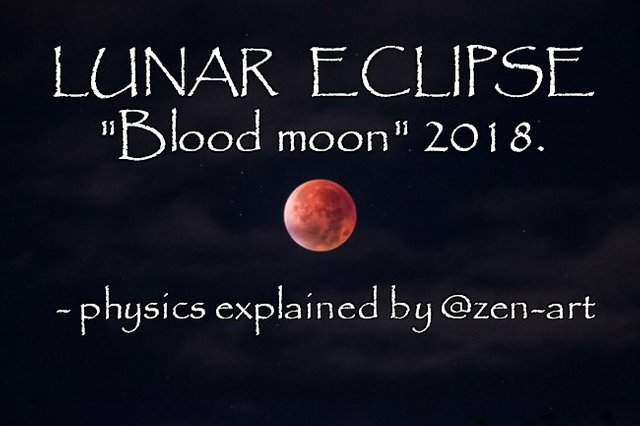
It was cloudy at my place and I was going outside every fifteen minutes to search for the Moon at east and southeast area in the sky. There were probably more than 10 of those hopefull searches and I did get lucky two times and saw that red marvel. I was a bit disappointed since there was no opportunity for a good picture so I will result in using photos of others in this post. All authors will be credited at the end of the post and every photo will be a link so if you click on it, it will take you away to the original place where the photo was taken from. Let's dive into this topic and learn everything about lunar eclipses.


Before we go any further, let's see how the Moon behaves. This celestial object rises in the east and sets in the west. We see it that way because it is orbiting our planet just like the Earth is orbiting the Sun. If you look at the Moon's movements across the sky, you will see that it moves eastward, with respect to the stars, by about 13 degrees per day. When we compare its movements to those of the Sun, the Moon moves eastward with respect to the Sun by about 12 degrees per day. This is why the Moon rises later and later and you see it rising in the morning, sometimes afternoon and, of course, sometimes at night. It sets in the same behavior, later each day, depending on its position.
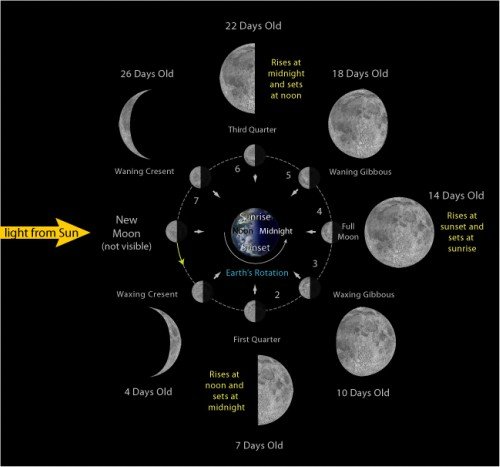
Our modern calendar is not directly tied to the Moon but we call it a month because of it since the marking of time passing in all cultures was a product of looking at celestial bodies. With 12 degrees each day, it takes the Moon 29.5 days to complete a full circle.
The Moon DOES NOT shine!
The reason we see the Moon as if it is shining is because it is reflecting the light from the Sun. The illuminated side of the Moon is always the side that's facing toward the Sun. We have different names for those phases when we see a different amount of the Moon illuminated. Moon is new when it is near the Sun in our sky, and full when it is opposite of the Sun.
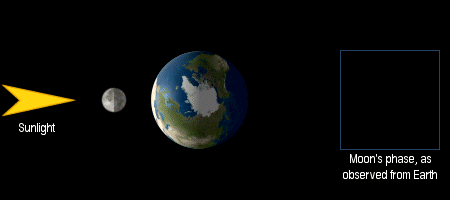
The Moon has a spherical shape and even though there is always half of the sphere illuminated, the amount of the Moon we see depends on our viewing direction. What we call a "New Moon" is when we do not see it at all because we are looking at its dark side when it is near the Sun. When it gets in the position that is opposite the Sun, we are looking at the Moon's illuminated side so we see a full Moon.


When we start talking about eclipses, we define them as the moving of one celestial object into the shadow of another. From our planet, we can clearly see eclipses of the Moon and the eclipses of the Sun but those are pretty different from each other.
Solar eclipse
Solar eclipse happens every 18 months and it usually lasts for a couple of minutes. When the Moon moves between the Sun and Earth, it blocks the light of the Sun from reaching Earth. It casts a shadow onto Earth and we have a solar eclipse. Depending on where we are on Earth we will either see a total or a partial solar eclipse. The Moon casts 2 shadows on Earth, one is umbra, it is the dark center of the shadow and it gets smaller when it reaches the Earth. The other is penumbra and that one gets larger when it reaches the Earth. If you are standing in the penumbra, you will see a partial eclipse and if you are in umbra the eclipse seen will be total.
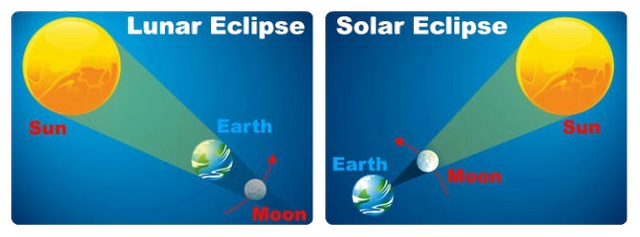
Lunar eclipse
A lunar eclipse can last to a couple of hours and there are at least two partial lunar eclipses every year. As the Earth is moving around the Sun, the Moon is moving around the Earth. There are situations when the Earth comes in between the Moon and the Sun and casts its shadow onto Moon. It blocks the sunlight that is normally reflected by the Moon.


Only when the Sun, Moon, and Earth are closely aligned it is possible to observe a lunar eclipse.
Since the lunar orbit is not perfectly aligned with the Earth's orbit (shifted by around 5 degrees), the Moon does not always pass exactly through the middle of the Earth's shadow. You can see the Moon passing through the umbral and penumbral shadow on the animation right from this text.
Total or partial?
Total lunar eclipse occurs when the entire Moon passes through the Earth's umbral shadow and the partial occurs when the Moon passes through the Earth's penumbral shadow.
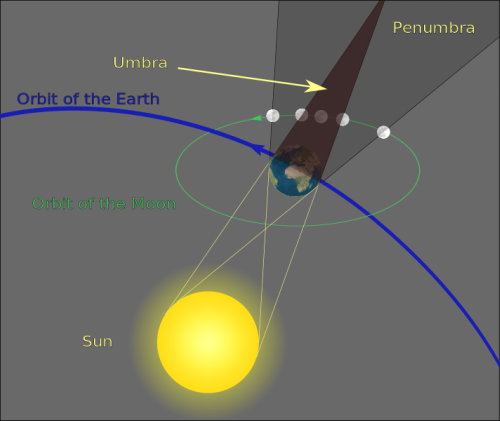


Total eclipse of the Moon is often referred to as the Blood Moon. The answer to the question why is the Moon seen red is the same as that for questions why do we see the sky blue and why are sunsets red. It has everything to do with the nature of light. I have covered light in my previous posts and if you are interested in how light behaves, check out HOW DO WE SEE COLORS. For those of you who want the answer now, read along...
About 80% of Earth's atmosphere is made of nitrogen gas, and most of the rest is oxygen gas. White sunlight, which has all the colors of the spectrum, is refracted in a way that makes the Moon appear orange-red. We see the sky blue during the day because our eyes are more sensitive to that color and the Sunlight is refracted in the atmosphere in a certain way. During a sunset or sunrise, the sunlight passes through a lot more atmospheric gas which filters out blue light so we are left with red and orange.
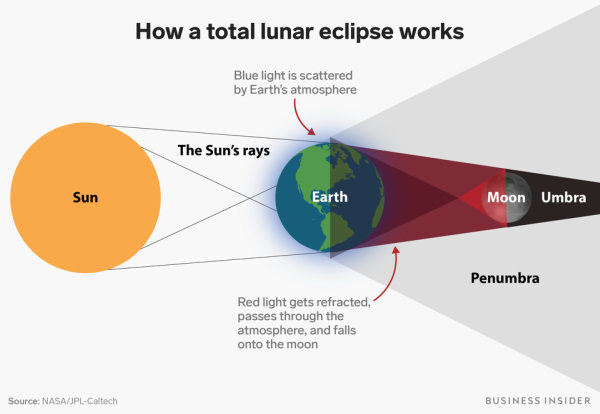
The Moon can take on different shades of red during a total lunar eclipse, depending on the conditions of the Earth's atmosphere at the time of the eclipse. There are many factors here that play a role, from dust particles, water droplets, clouds, and mist to volcanic ash and dust in the atmosphere. All those factors affect the way the light will reflect. There is a five-point brightness scale called Danjon Scale that ranks and assigns values to lunar eclipses based on appearance and brightness. It ranges from 0 to 4 and was created by French astronomer A.L.Danjon.
And now you know
the basics about lunar eclipse!
To learn more about this topic, be sure to check out these resources:
Why does the Moon turn red?
Here's the difference between a lunar and solar eclipse
Types of lunar eclipses
'Blood Moons' Explained
The Moon and Eclipses
What Is an Eclipse?
KEEP YOUR SMILE ON
RESPECT YOUR INNER GENIOUS!

If you are interested in something physics (or science in general) related, tell me and I would be happy to make a post about it and explained it. Promoting science and making it understandable gives me great joy, I would be happy to help you.

Image sources:
- cover image is from pngtree and is royality free, it can be found here
- clipart Moon in my titles is from FREE CLIPART LIBRARY, it can be found here
- Moon phases are from http://astro.unl.edu and can be found here
- gif animation of Moon phases is from gify and can be found here here
- lunar and solar eclipse images are from www.nasa.gov and can be found here
- lunar orbit gif and umbra shadow image are from khanacademy.org and can be found here
- red Moon image is from thesun.co.uk and can be found here
- how a total lunar eclipse works image is from businessinsider.com and can be found here
- clipart Moon in my titles is from FREE CLIPART LIBRARY, it can be found here
- Moon phases are from http://astro.unl.edu and can be found here
- gif animation of Moon phases is from gify and can be found here here
- lunar and solar eclipse images are from www.nasa.gov and can be found here
- lunar orbit gif and umbra shadow image are from khanacademy.org and can be found here
- red Moon image is from thesun.co.uk and can be found here
- how a total lunar eclipse works image is from businessinsider.com and can be found here
PROUD MEMBER OF:



@steemitbloggers

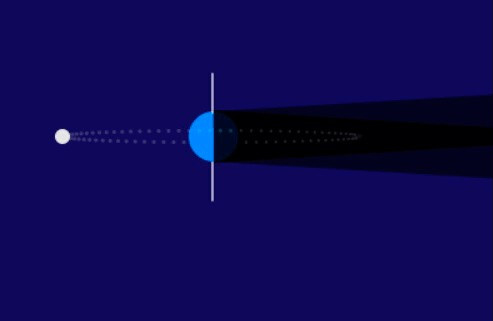
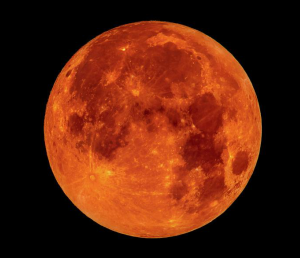
Thanks for the thorough explanation.
Imagine our ancestors who has no understanding of physics and celestial movements, sights like a blood moon must have filled their minds with imagination and/or terror.
Oh yes, there are some great myths about this and explanations like a dragon eating the Moon 💚
This post was spotted by @theluvbug and has received a 100% upvote and a resteem. If you would like to possibly receive future support from @theluvbug then please make use of the #theluvbug tag.
I AM
Spreading the STEEMIT LOVE with upvotes and resteems of INSPIRING, MOTIVATIONAL & POSITIVE Steemit content. Use #theluvbug to get my attention :)
......
FOLLOW ME ON TWITTER
Had a glimpse of it. I initially intended to stay all night to see it disappear, unfortunately I feel asleep 😂😂
Thank you for the love 💚💚💚
I think I was writing a blog post last night when I looked up from my balcony and saw the red marvel. I guess I am lucky to live in a remote location with clear skies and minimal city lights.
You were lucky to see it and not have clouds in the way and I am glad you enjoyed it 💚
it really was a sight to behold wasn't it!!!
Yes it was, very beautiful and interesting to see 💚
very interesting info, here we didnt get to see it
I am sorry to hear that but I hope you at least find the photos and explanation from this post useful for the next time 💚
@zen-art Ohh yes it was a great post
Great post and nicely explained, as always <3 <3 I did not catch it last night, I don't know if I could see it because it was a bit cloudy... :(
Have a great day krafnaaa! <3
Clouds were giving us all a headache, I know. I am glad you liked this honey, you have a great day too 💚💚💚
It really was a sight to see @zen-art your descriptive article explains it well!
Thank you, I am glad you found the article interesting 💚
Ah great job!!!! I missed it as i was ASLEEEEEEEEP..LOL
There will be another opportunity to see it do not worry 💚
I have seen loads of eclipses and loads of red moons in my time :0P
If you would like to support the educational community by delegating to @steemiteducation, please click on any of the following links. This will ensure that more teachers are supported on a daily basis.
100SP 200SP 300SP 400SP 500SP 750SP 1000SP 2000SP 3000SP 4000SP 5000SP 10,000SP 25,000SP
You've done it again, haven't you? A marvelous explanation that everybody can follow. Very nicely done.
You really do this 'splainin' thing well. I'm so glad I get to read them. My life would be poorer with out them.
Thank you for your kind words honey, I am glad you like my physics explained series 💚💚💚